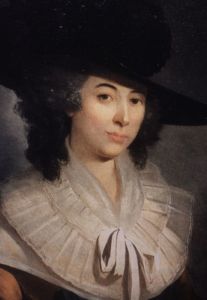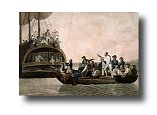Elizabeth Betham was born in 1754, the second daughter of Richard Betham, LL.D., who was Collector of Customs and Water Bailiff at Douglas on the Isle of Man. Click for larger image.For a woman of her times she received an excellent education and has been described as “a cultured and accomplished lady.” When she met William Bligh in 1789, soon after his return from Cook’s third voyage, there seems to have been an immediate mutual attraction between the two. They were married on February 4 the next year at the Parish Church of Onchan in Douglas on the Isle of Man.
Through her family connections, Elizabeth was a tremendous help to Bligh in his career. Her uncle was Duncan Campbell who employed Bligh in his fleet of merchant ships and used his acquaintance with Sir Joseph Banks to either recommend or suggest Bligh for the position as commander of the breadfruit expedition.
It was also through Elizabeth’s family that Bligh came to know the Heywoods. Peter Heywood, as well as Thomas Hayward and John Hallett, all came to the Bounty on her suggestion (Hallett’s sister Ann was a bosom friend of Elizabeth’s). The fact that Bligh was to hate Peter Heywood and his family for the rest of his life (being convinced that he had not only been a mutineer but one of the instigators of the mutiny) did not reflect on Elizabeth. Nor did the fact that her family knew the Christians (the Isle of Man is small) and that this connection had been a factor in Bligh’s accepting Fletcher on board the Britannia for two voyages before the breadfruit expedition.
Betsy, as Bligh referred to her, bore her husband six daughters: Harriet, Mary, Elizabeth, Frances and Jane (twins born after Bligh had left on the first breadfruit expedition), and Anne. She also bore him a pair of boy twins in 1795, named William and Henry, but they died within twenty-four hours.
She was probably Bligh’s only friend in life. He had two patrons who stood by him: Betsy’s uncle Duncan Campbell and Sir Joseph Banks, but, as far as we know, he had no friends. Bligh did not have the kind of personality required to keep a friend; he was far too preoccupied with proving his own excellence and lack of faults to engage in the giving part of a give-and-take friendship.
Betsy, however, was devoted to him and stood by him through thick and thin. When stories began to arrive from New South Wales that were uncomplimentary to Bligh, to say the least, she actively campaigned on his behalf writing letters right and left to persons with influence, especially of course to Banks.
Most of their married life they had been apart from each other. When Bligh came back from New South Wales in 1810, his active career was finished and the two of them might have looked forward to spending his retirement years together. But Betsy’s health was broken – some say as a result of the agony she had experienced when faced with stories about her husband which she could not or would not believe. She died on April 15, 1812, at the age of fifty-nine, and was buried in the family grave in Lambeth Churchyard where Bligh was to follow her five and a half years later.
|


